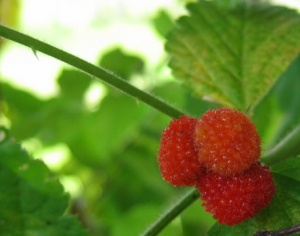Difference between revisions of "Buaq pidang runut"
Jump to navigation
Jump to search
(New page: thumb|300px|'''Bua'Pidang Runut'''<br>Photo by [[user:sibez_agan|sibez_agan ]] == Pronunciation == ==Common Names == ;Kelabit: *Bua' Pidang Runut (Bua...) |
|||
| Line 21: | Line 21: | ||
;English: | ;English: | ||
| − | #R. moluccanus has a simple leaf and is a scrambling shrub reaching 2 to 3 m high. The stems and leaves are armed with medium sized spines. The leaves are large and lobed and the upper surface hairy. The leaf has a crinkled surface and the underside is white. The flowers are white and borne in clusters. The berries are about 1 cm across. They are red and with little flavour. [[#References|<sup>(3)</sup>]] | + | #R. moluccanus has a simple leaf and is a scrambling shrub reaching 2 to 3 m high. The stems and leaves are armed with medium sized spines. The leaves are large and lobed and the upper surface hairy. The leaf has a crinkled surface and the underside is white. The flowers are white and borne in clusters. The berries are about 1 cm across. They are red and with little flavour. Usually eaten by children. [[#References|<sup>(3)</sup>]] |
#The plant was formerly used in connection with ceremonies to keep peace with the spirits. [[#References|<sup>(1)</sup>]] | #The plant was formerly used in connection with ceremonies to keep peace with the spirits. [[#References|<sup>(1)</sup>]] | ||
Revision as of 13:36, 30 November 2007
Pronunciation
Common Names
- Kelabit
- Bua' Pidang Runut (Bua Pidang Runut)
- English
- Broad leafed bramble, Molucca Bramble (3)
- Malay
- Tumbuhan liar raspberi
Encyclopedic info
See also Bua' Pidang
- Scientific name
- Rubus moluccanus (1)
- English
- R. moluccanus has a simple leaf and is a scrambling shrub reaching 2 to 3 m high. The stems and leaves are armed with medium sized spines. The leaves are large and lobed and the upper surface hairy. The leaf has a crinkled surface and the underside is white. The flowers are white and borne in clusters. The berries are about 1 cm across. They are red and with little flavour. Usually eaten by children. (3)
- The plant was formerly used in connection with ceremonies to keep peace with the spirits. (1)
- Malay
- ?
References
- Ethnobotany of the Iban & Kelabit by Hanne Christensen
- Wikipedia:rubus
- Ecoport
